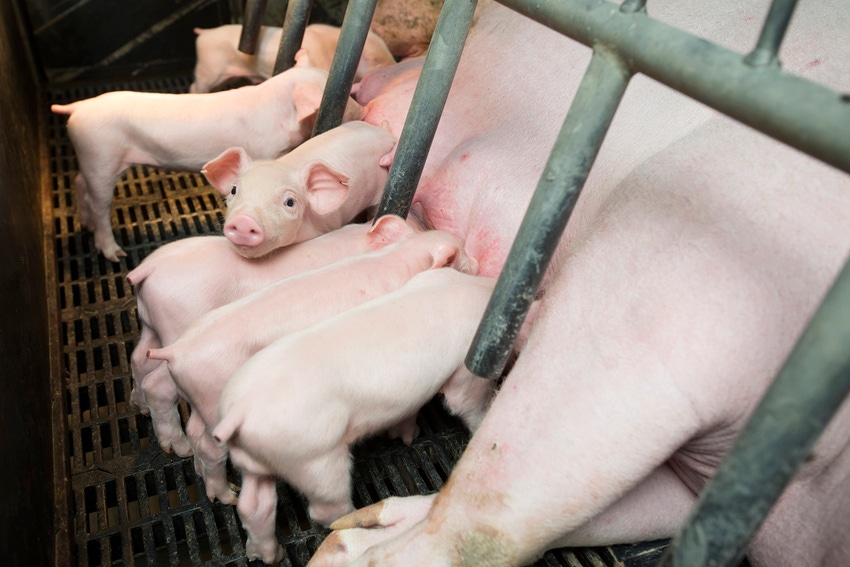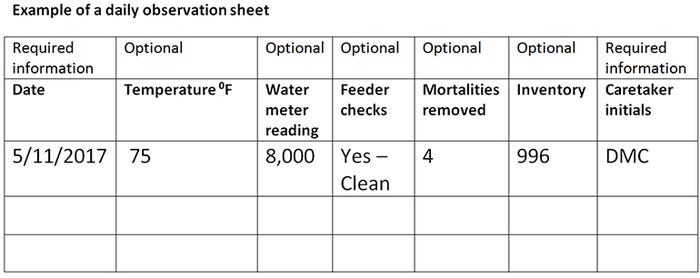The overarching goal of the common audit process is to provide consumers greater assurance of the care taken by farmers and pork processors to improve animal well-being and food safety.
May 19, 2017

By Dyneah Classen, DVM, Carthage Veterinary Service Ltd.
Harvest facilities (packers) have started third-party auditing requirements for hog farms supplying or marketing hogs to them. The audit programs initially varied by packer and were intended to assure consumers that the animals that produce their pork are well cared for throughout all stages of production. In 2013, the National Pork Board identified a need to streamline the process and began a task force to develop a Common Swine Industry Audit. This task force would involve stakeholders from all aspects of swine production to ensure the goals of the audit could be met with reasonable expectations. The CSIA would also create a standardized audit and prevent complications to farms of having to comply with multiple auditing programs from each packer.
In June of 2014, the NPB brought the CSIA to a smaller group of pork producers and packers to explain its goal and benefits. The NPB wanted a credible, affordable solution to assure on-farm animal well-being. In October 2014, the NPB officially announced that a new common swine industry audit platform for pork producers, packers and processors was certified by the Professional Animal Auditor Certification Organization. The latest versions of the Pork Quality Assurance Plus and PQA Site Assessment have been updated to include information and help farms prepare for the CSIA. The common audit and valuable resources can be found on the NPB website.
The purpose of the CSIA is the same as the individual packer audits to verify that the pork industry’s approved animal well-being standards are followed. There are four focal areas: records, animals, facilities and caretakers. It is based on a points scale to determine the grade with five critical questions that are only pass and fail.
The five critical questions are:
1. Were any willful acts of abuse or neglect observed during the audit?
2. Are animals euthanized in a timely manner?
3. If euthanasia is observed, are animals handled humanely during the process?
4. If euthanasia observed, are animals euthanized in lace or is suitable equipment available to move non-ambulatory animals so they can be humanely euthanized?
5. If euthanasia is observed, do caretakers confirm insensibility and death after the euthanasia method is applied and before being removed from the facility?
If one of these questions is answered with a fail, which means the auditor observed willful acts of abuse or improper euthanasia, the audit will immediately end as a failed the audit.
Preparing for a CSIA
There are two third-party auditing companies being hired by packers to complete CSIAs today: Validus and FACTA.
Typically a procurement agent from the harvest facility will reach out to the finishing farm and sow farm to identify the contact person. I would encourage all farmers to identify a single point of contact especially if there are multiple sites to be audited. This will be the first notification that a CSIA is needed. The audit requires a third-party auditor to visit both the finishing farm and the sow farm for that flow. Depending on the location, the auditor may be the same or different person. Most auditors are assigned a geographical location for efficiency.
The procurement agent will then give the farms contact information to the third-party auditing service. The administrative assistant from the third-party auditing service will take down some initial information like farm location, size of the farm, biosecurity downtime and protocols to enter the farm(s). In a few days you will be contacted again to schedule an audit date.
Once the audit date has been set, start gathering the necessary paperwork to complete the CSIA. Using the auditing template from the NPB and following the first CSIA the veterinarians at Carthage Veterinary Service Ltd completed a Carthage Care Check List. This list helps clients prepare for the upcoming CSIA.
Having a clean and organized office with the needed paperwork laid out on a table helps set the tone for the audit. It shows the auditor you are organized and are fully on board with the process. I have had an auditor share with me that if he finds a clean office, he finds a clean barn and well cared for animals. The old adage still holds true, “you only have one chance to make a great first impression.” I also feel that having everything laid out prevents the frenzy of rushing around the office, trying to locate needed materials. I feel more relaxed and calm knowing the needed information is laid out on the table ready to go (as do many of my clients).
What paperwork do you need? Review the CSIA on the NBP website. Contact your veterinarian. Like Carthage, many veterinarians provide clients with preparation services. The CSIA uses the farm’s own Standard Operating Procedures to base compliance. If you have an SOP that is not correct or needs updating, do so before the audit. The CSIA requires that paperwork and records be kept for one year to prove compliance (or if a new farm from the point of animal stocking). However, it does not specify what that paperwork has to look like or include. This means that, for example, your daily animal observation sheets can include information that is valuable to the farm from a production standpoint, such as temperature, water intake, feeder checks, mortality, etc. In this example make sure that the date and employee initials are included as those are required per the CSIA.

Please note at this time if the audit is requested by Hormel or Triumph there are additional questions that are required by these packers that are in addition to the CSIA.
Hormel will ask for animal mortalities for both sows and piglets for the last year as a percentage, as well as the transportation mortality to the harvest facility.
Triumph will ask about the primary form of euthanasia for suckling piglets and for an animal caretaker to review the SOP on suckling pig euthanasia.
The auditor assigned will contact you about one week prior to the scheduled audit date. At this time arrange for a meeting time and place. I often meet auditors off-site for biosecurity proposes and to ensure they can locate the correct site and have them ride with me or follow me to the farm. If the farm is shower in/out, make sure the clothing and boot sizes the auditor needs are available and in good condition. If the farm is not shower in/out, the auditor is prepared to bring his/her own coveralls and boots or you can provide them. All necessary details should be agreed upon during this call. Auditors are expected to comply with all on-farm biosecurity procedures.
Completing the CSIA
Meet the auditor at the agreed upon location and time. Explain any needed biosecurity entry protocols into the farm. Once inside, introduce the auditor to any additional staff. The auditor usually speaks mainly with the farm manager, but for SOPs may request to speak to other staff members to assess if they were also trained on that area and that they understand and use the farm’s SOP.
The auditor will need to review both the paperwork and the animal areas. When reviewing the paperwork portion of the audit if you are not sure that a record retained by the farm applies, go ahead and present the item to the auditor. The farm may or may not receive points, but will receive feedback from the auditor as to why/why not that record document is not compliant.
The animal area will use the PQA site assessment calculations to determine how many animals must be observed. The auditor may look at every animal as they walk past. Based on these calculations, the auditor will ask the farm team to stand up every animal at a certain interval. For example, every 25th animal will need to stand to be observed. Validus and FACTA auditors have been instructed that when walking through farrowing not to require a lactating sow to stand and disrupt the nursing process. The auditor will still observe the example 25th animal in farrowing more closely.
During the audit, the auditor is there to do that. They may make personal suggestions or engage in “small talk.” As long as the farm is compliant with the CSIA required information, it is up to your discretion to implement any of the auditor’s suggestions. If you ever feel the auditor has overstepped the bounds of the CSIA or has rejected a document that should have met the CSIA requirements you can reach out to your veterinarian or to the third-party auditing service, and report the auditor or request clarification.
After the CSIA
The auditor may share your final score or that you have passed at the end of the audit. A final copy of the audit will first be sent to the harvest facility and procurement agent requesting the audit. The procurement agent will then send a list of correction actions if any items that were found to be lacking during the audit. They may/may not include the copy of the audit as well. The corrective action report is expected to be completed and returned to the procurement agent within 30 days. Once the corrective actions are returned if you have not yet received a copy of the audit you may request a completed copy from the third-party auditing service or from the harvest facility.
Most other harvest facilities will accept an audit completed by another packer if it has been done within the last year. If the farm receives a request for another audit, please ask the new procurement agent if they will accept the earlier audit. Always ask or you will complete another audit with the second packer.
I always encourage farms to review what items were missed during a CSIA and learn for the next one.
There is no set interval between audits. Farms may receive a request for a CSIA every year or go longer between audits. This is truly up to the harvest facilities and procurement agents.
Goal of audit tool
The overarching goal of the common audit process is to provide consumers greater assurance of the care taken by farmers and pork processors to improve animal well-being and food safety. The audit tool builds on the existing PQA Plus program and expands it to serve as a single, common audit platform for the pork industry.
To help avoid duplicative, costly and inefficient audit programs that are commonplace in some countries, this tool is designed to:
• Meet individual company and customer needs.
• Be focused on outcome-based criteria that measure and improve animal welfare.
• Provide clarity to producers about audit standards and expectations.
• Minimize duplication and prevent over-sampling.
• Ensure greater integrity of the audit process through consistent application.
• Provide an objective, science-based platform to facilitate continuous improvement in animal care.
You May Also Like



